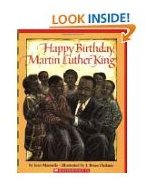4 Activities for a Martin Luther King Jr. Lesson Plan for Kindergarten
Planting Seeds
Martin Luther King, Jr. lesson plans enable teachers to plant seeds of understanding in the area of civil rights. Kindergarten
students, given hands-on lessons, learn quickly. These lesson plans will enable the classroom teacher to fill the objectives of multicultural education by:
- Introducing students to the constitutional rights of all citizens
- Beginning the process of teaching students to think critically
- Promoting an awareness of social justice within the classroom as well as in the community
- Developing an understanding of the diversity of our world
Dr. King was the catalyst for the changes we see today in society. Integrated classrooms, buses, restrooms, as well as the ability for people of all races to enjoy movies, church, parks, and communities together are all thanks to the efforts and leadership of Dr. King. Teaching children about these accomplishments as well as introducing them to the history of Dr. King and the Civil Rights Movement gives them a foundation for critical thinking that will carry them into their future.
Objectives
The MLK Day activities will
- Teach students about Dr. King
- Introduce the concepts of civil rights, diversity, justice and equality
- Illustrate ways to be inclusive and tolerant
Materials Needed
-
Book: Happy Birthday, Martin Luther King Jr. by Jean Marzollo

-
Book: I Have A Dream by Martin Luther King, Jr., Forward by Coretta Scott King
-
Large poster size bus - use large art paper to create the bus - draw big windows
-
Old magazines
-
Safety scissors
-
Paste or glue sticks
-
Paper
-
Crayons or paint
Activity 1 - The Bus Poster
The Civil Rights Movement ended segregation. This activity helps students understand that we are all equal.
- Read, Happy Birthday, Martin Luther King, Jr. to the class. Discuss the contributions Dr. King made to civil rights. Talk about how students of different races could not ride together in the school bus. Ask students how they might feel if their friends could not ride the bus with them.
- Have students cut out pictures of people of all cultures from old magazines.
- Have students paste their pictures in the windows of the bus.
- If possible, laminate the bus poster.
- Hang it on the wall with the caption, We All Ride Together
Activity 2 - We Are All Different
While we are all equal, we are also all different. This activity helps students to understand and celebrate differences.
- Ask each child to share some information about their culture and traditions with the class. This does not necessarily have to be about race. Have children share family traditions, religious traditions, if another language is spoken in their home, etc.
- Provide each child with a sheet of paper and crayons or paints (or another medium of your choice).
- Ask the children to draw a picture of themselves participating in a custom or tradition that another student discussed.
- Have each student discuss his or her picture with the class. What is their picture of and why did they choose to draw this particular tradition or custom?
Activity 3 - I Have a Dream
Dr. King’s powerful speech I Have a Dream laid the foundation for the Civil Rights Movement. This activity helps students understand

that we all have hopes for a better tomorrow.
- Read students the book, I Have a Dream. The text of the book is the speech Dr. King gave accompanied by illustrations.
- Discuss what Dr. King’s dream was. Explain to them the difference between a sleeping dream and a dream that is a hope or wish.
- Have students draw a picture of a wish or dream they have for a better future.
- At the bottom of their picture, help them finish the sentence, “I have a dream that…” Ask them to describe their picture.
Activity 4 - Names
What we call others and ourselves is another concern on which Dr. King raised the collect conscience. In this activity, students will talk about the positive effect words can have on people.
- Discuss how names can be positive as well as negative.
- Ask the students if they know how they got their names.
- Tell them the story behind your name.
- Explain how many cultures give great thought to naming children, because they believe the name matches the child. (i.e., names have meaning such as Mary, which means “wished-for child” or Leonard, which means “lion strength”)
- Brainstorm with students words to describe their friends - pretty, nice, kind, fair, etc.
- End the lesson by reiterating the importance of using positive terms to talk about others as well as ourselves.
Suggestion: have several multicultural baby name books so that you can look up the student’s names for them.
You are celebrating equality, peace and justice with this lesson that allows kindergarteners the opportunity of hands-on activities. Young children learn more quickly with hands-on activities, and this is a positive method of setting the foundation of awareness of social justice issues among the students.
Resources and References:
National Park Service: Martin Luther King Jr - Lesson Plans and Guides
Enchanted Learning: Martin Luther King Jr Coloring Page
